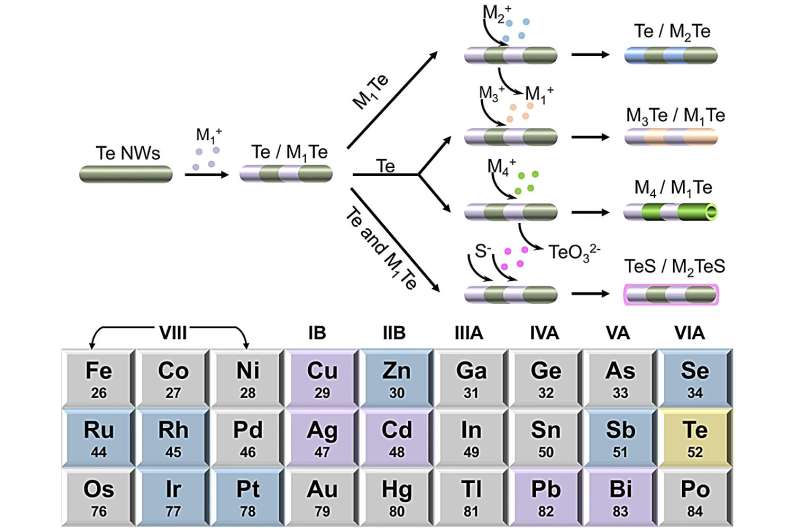This article has been reviewed according to Science X's editorial process and policies. Editors have highlighted the following attributes while ensuring the content's credibility:
fact-checked
peer-reviewed publication
proofread
Synthesis method for 1D segmented heteronanostructures uses stress-induced axial ordering

One-dimensional segmented heteronanostructures (1D-SHs) are promising candidates in fields such as photoelectrocatalysis (PEC) and thermoelectrics. Currently, the synthesis of 1D-SHs mainly focuses on sulfides and selenides, with relatively less research on telluride materials, yet tellurides have significant application prospects in energy storage and optoelectronics. However, a simple and controlled synthesis of telluride 1D-SHs materials has always been challenging.
A research team led by Academician Yu Shuhong from the University of Science and Technology of China (USTC) of Chinese Academy of Sciences (CAS) has developed a method for synthesizing 1D-SHs based on stress-induced axial ordering. They also tracked the changes in stress and strain energy during the evolution of periodic ordered structures using a continuous phase field model.
The study is published in Nature Communications.
First, the researchers selected tellurium nanowires (NWs) with high aspect ratio as the model structural units, and dispersed them in ethylene glycol, with the complexing agent NH4SCN and a stoichiometrically deficient amount of silver ions Ag+ added. Then the Te/Ag2Te 1D-SHs with distinct regular segmented structures appeared quickly.
To verify its properties, the researchers used transmission electron microscopy and energy dispersive X-ray spectrometer to observe its segmented uniformity and determine the elemental distribution. The researchers further verified the biphasic nature of the Te/Ag2Te segmented heterostructures using methods such as X-ray diffraction spectra, Raman spectroscopy, and X-ray photoelectron spectroscopy.
In addition, through in-situ liquid phase transmission electron microscope, researchers summarized that the formation process of Te/Ag2Te 1D-SHs went through three-stages evolution: island generation, stripe penetration and segment ordering.
To explore the energy change and stress distribution during the formation of Te/Ag2Te 1D-SHs, the researchers reproduced the formation, growth, and ordering processes of Ag2Te island structures.
The results showed that the initially generated Ag2Te islands were affected by radial tensile stress and axial compressive stress, growing along the radial direction to form poor-ordered stripe structures. Subsequently, theses stripe structures gradually evolve into periodic segments.
Researchers also synthesized a series of 1D-SHs of tellurides, including materials like Pd, Cu, Bi, Cd, etc. In addition to this, by combining simple chemical post-transformations, the researchers constructed a library of axial 1D-SHs materials involving 13 elements in the periodic table.
Researchers also proposed a simple solution-phase method for synthesizing 1D-SHs, and combined with a simple chemical post-transformation process, 25 1D-SHs including 17 NW-NW and 8 NW-nanotube nanostructures.
This work not only enriches the material library of 1D-SHs, but also provides a new approach for the precise preparation of function-oriented nanomaterials and the exploration of ordered reconstruction of heteronanostructures.
More information: Qing-Xia Chen et al, Stress-induced ordering evolution of 1D segmented heteronanostructures and their chemical post-transformations, Nature Communications (2024). DOI: 10.1038/s41467-024-47446-7
Journal information: Nature Communications
Provided by University of Science and Technology of China




















